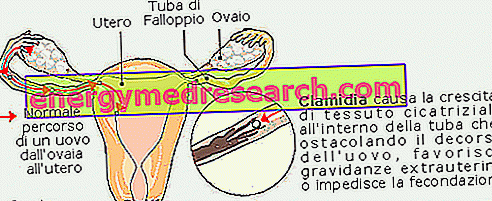Generality
Pelvic inflammatory disease is an inflammatory process, acute or chronic, which affects female reproductive organs and adjacent structures. The most commonly affected sites are the fallopian tubes and to a lesser extent the uterus, the ovaries and the pelvic peritoneum.
Pelvic inflammatory disease is mostly caused by sexually transmitted infectious agents ( Chlamydia trachomatis, Neisseria gonorrhoeae, Mycoplasma hominis ...) or by other microorganisms present in the female genital area. The infection, therefore, is transmitted mainly by an ascending route, while in less than 1% of cases it is due to an extragenital (often appendicular) focus that reaches the reproductive system through blood, lymphatic or contiguity.
Symptoms
To learn more: Symptoms of pelvic inflammatory disease
The most obvious manifestation of pelvic inflammatory disease is pain, even of strong intensity, located in the lower abdomen and pelvis. Acute episodes are often associated with other characteristic symptoms, such as:
- dyspareunia (pain during sexual intercourse)
- leucoxantorrhea (vaginal discharge with bad smell)
- spotting (intermenstrual bleeding)
- hypermenorrhea (particularly abundant menstrual flow)
- low back pain (low back pain)
- low-grade fever or mild fever
- weakness
- diarrhea
- He retched
- urinary symptoms.
The clinical presentation of pelvic inflammatory disease is however very variable. In some cases, for example - especially when it is supported by the infection of Chlamydia trachomatis - the inflammation starts in an almost asymptomatic way. What apparently might seem good is actually an epidemiological problem of primary importance, both because it promotes the transmission of the disease and because it can seriously damage the reproductive organs of the woman.
Therefore, when the symptoms listed above appear even in a rather nuanced manner, it is important to interrupt the sexual activity and subject them to medical attention as soon as possible. An early intervention can in fact avert the risk that a common sexually transmitted disease, treatable with a very short oral antibiotic therapy, evolves into pelvic inflammatory disease and its fearsome consequences.
Causes and risk factors
The main risk factors for the development of pelvic inflammatory disease are represented by: multiple sexual partners, early sexual activity (biological defenses not yet fully formed), failure to use barrier contraceptive methods (condom), sexual tourism, relationships for payment and prostitution, IUD (recent insertion of intrauterine devices), drug addiction, history of pelvic inflammatory disease or any venereal pathology, poor or excessive personal hygiene (vaginal lavages, for example, upset the normal balance of the vaginal bacterial flora and can mask the symptoms that normally lead to a medical consultation). The age group most affected is between 20 and 25 years. Overall, pelvic inflammatory disease affects 1-2% of the sexually active female population.
The use of the contraceptive pill does not in any way limit the possibility of contracting sexually transmitted diseases, but may decrease the risk of pelvic inflammatory disease by increasing the density of the cervical mucus; this viscous liquid, in fact, represents a natural obstacle to the rise of bacteria in the upper genital tract. On the contrary, the voluntary interruption of pregnancy, childbirth or an endometrial biopsy favor the penetration of bacteria into the reproductive organs.
The most common infectious agents involved in pelvic inflammatory disease are Chlamydia trachomatis and Neisseria gonorrhoeae, although very often the culture test shows a polymicrobial infection. In non-EU citizens, the tubercular etiology must also be considered.
Pelvic inflammatory disease - Video: Causes Symptoms Cures
X Problems with video playback? Reload from YouTube Go to Video Page Go to Wellness Destination Watch the video on youtubeComplications
When the pelvic inflammatory disease, favored by the patient's neglect or subclinical course, lasts for a long time, it tends to become chronic. In this case, the repercussions on women's health are rather serious and the possibility of complications such as infertility, sterility, extrauterine pregnancy, recurrent episodes of pelvic pain, pain during sexual intercourse and recurrent genital infections increases.

As shown in the figure, in the absence of adequate treatment, pelvic inflammatory disease leads to the formation of scar tissue, adhesions and abscesses within the fallopian tubes.
For this reason, PID is the main cause of ectopic pregnancy, in which the fertilized oocyte - unable to reach the uterus - implants at the level of the tubes. These, however, have a lumen too narrow to accommodate the gestational sac and inevitably abortion or tubal rupture occurs; the latter event is particularly dangerous and jeopardizes the survival of the woman herself.
Diagnosis
The diagnosis of pelvic inflammatory disease can make use of numerous clinical and instrumental tests. These include the culture examination of the cervico-vaginal secretion, the urethral swab of the partner, the endometrial biopsy (taking a small sample of endometrium, tissue that internally covers the uterine cavity), laparoscopy (exploration by microtelecamera inserted through a very small small cut in the abdomen) and pelvic ultrasound (less invasive than the previous ones, it allows to reconstruct the image of the pelvic organs using ultrasounds). With regard to blood chemistry tests, there was an increase in the ESR (non-specific inflammation index), PCR and sometimes neutrophil leukocytosis.
Treatment
To learn more: Drugs for the treatment of Pelvic Inflammatory Disease
The treatment of acute, uncomplicated pelvic inflammatory disease is substantially antibiotic (possibly associated with painkillers). Given the generally polymicrobial origin and poor reliability of the examination of cervico-vaginal secretions (not necessarily the pathogens detected are the same as those found in the upper genital tracts), it is necessary to administer drugs with differentiated action on the pathogens most frequently involved in the etiology of disease. The evaluation and the possible treatment of the partner are fundamental, as well as the abstention from sexual relations for the whole duration of the treatment.
Only in the most severe cases and in emergencies, pelvic inflammatory disease obliges hospitalization to undergo intravenous antibiotic therapy or specific surgery.



